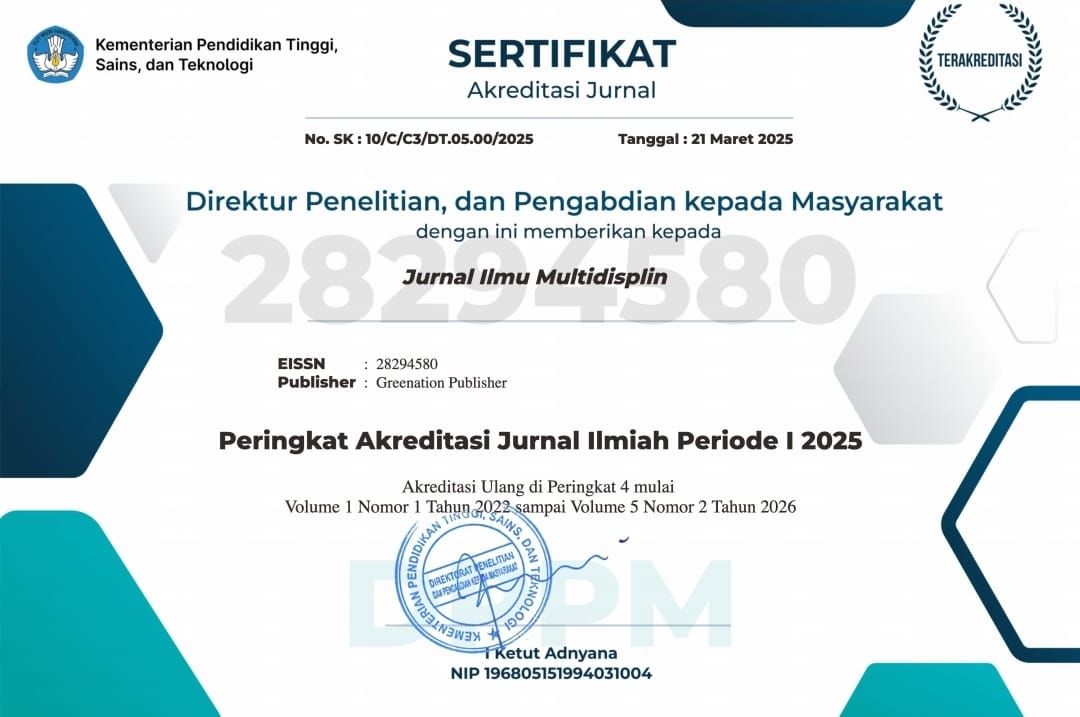Pengaruh Kurs dan Modal Sendiri Terhadap Laba Bersih pada PT. United Tractor Tbk di Bursa Efek Indonesia (Bei) Periode 2006-2018
DOI:
https://doi.org/10.38035/jim.v1i4.138Keywords:
Exchange Rate, Capital, Net Profit, Growth, SalesAbstract
This study aims to examine and determine the effect of Exchange Rate and Equity on Net Income of the company PT. United Tractors. Tbk is listed on the Indonesia Stock Exchange (IDX) for the 2006-2018 period. This study uses quantitative data sourced from secondary data. The data analysis technique used is the classical assumption test, descriptive statistical test, and hypothesis testing. The results of this study found that researchers carried out the F test, which is a simultaneous test on exchange rates and equity variables on net income. On two variables at once, namely the Exchange Rate and Own Capital on the Net Profit variable, the results are 0.000 <0.05 and fcount 18.448 > Ftable 3.98 so that it can be concluded fcount > Ftable thus there is an effect of the Exchange Rate and Equity variables simultaneously on Net Profit . Then the t test is tested partially on the exchange rate and equity variables on net income with the results of the exchange rate variable and the result is that the value of tcount (-1.179) while ttable is 2.228 can be concluded that tcount <ttable, thus there is no effect between the exchange rate on Net profit. Meanwhile with the Own Capital variable and the result is that the value of tcount is 4.278 while ttable is 2.228 it can be concluded that tcount > ttable, thus there is an influence between Own Capital on Net Income.
References
Brigham & Houston. (2006). Dasar-dasar Manajemen Keuangan Edisi ke 10. Jakarta: Salemba Empat.
Haryfapratama. (2012). https://haryfapratama.wordpress.com/2012/12/30/perusahaan-go-public-united-tractors-tbk/
Hasibuan, M.S.P. (2010). Manajemen Dasar, Pengertian dan Masalah. Jakarta: Bumi Aksara.
Husnan, Saud dan Pudjiastuti, Enny. (2006). Dasar-dasar Manajemen Keuangan. Yogyakarta: Liberty.
Irham, F. (2011). Analisis Laporan Keuangan. Bandung: IKAPI.
Kamaludin dan Indriani, R. (2010). Manajemen Keuangan “Konsep Dasar dan Penerapannya. Bandung: IKAPI
Kasmir. (2008). Analisis Laporan Keuanagan. YKPN : Yogyakarta
Mahduh, M.H. (2004). Manajemen Keduuangan, Edisi ke 1. Yogyakarta: BPFE.
Manulang. (2005). Pengantar Manajemen Keuangan. Yogyakarta : ANDI OFFSET
Mardiyatmo. (2005). Jenis-Jenis Modal https://www.google.com/search?source=hp&ei=BHLwXYuALOC-
Munawir. S. (2004). http://elib.unikom.ac.id/files/disk1/131/jbptunikompp-gdl-s1-2007-sitiromlah-6511-bab-ii.doc
Munawir, S. (2010). Analisis Laporan Keuangan. Yogyakarta: Liberty
Osrita, H. (2016). Pedoman Penulisan Skripsi. Jambi: Fakultas Ekonomi Universitas Batanghari.
Prayoga, Irfan Bagus Dwi. (2012). Pengaruh Laba Bersih dan Komponen-Komponen Akrual terhadap Arus Kas Aktivitas Operasi Di Masa Mendatang. Skripsi S-1. Semarang: Universitas Diponegoro.
Riyanto, B. (2001). Dasar-dasar Pembelajaran keuangan. Yogyakarta: Liberty.
Setia, L. (2004). Manajemen Keuangan, Edisi Revisi. Yogyakarta: ANDI.
Silalahi, Ulber. (2012). Metode Penelitian Sosial. Bandung: Refika Aditama
Siswanto. (2006). Pengantar Manajemen. Jakarta: Bumi Aksara.
Sutrisno. (2009). Teori dan Konsep Aplikasi. Yogyakarta: EKONISIA.
Downloads
Published
How to Cite
Issue
Section
License
You are free to:
- Share— copy and redistribute the material in any medium or format
- Adapt— remix, transform, and build upon the material for any purpose, even commercially.
The licensor cannot revoke these freedoms as long as you follow the license terms.
Under the following terms:
- Attribution— You must give appropriate credit, provide a link to the license, and indicate if changes were made. You may do so in any reasonable manner, but not in any way that suggests the licensor endorses you or your use.
- No additional restrictions— You may not apply legal terms or technological measures that legally restrict others from doing anything the license permits.
Notices:
- You do not have to comply with the license for elements of the material in the public domain or where your use is permitted by an applicable exception or limitation.
- No warranties are given. The license may not give you all of the permissions necessary for your intended use. For example, other rights such as publicity, privacy, or moral rightsmay limit how you use the material.




























